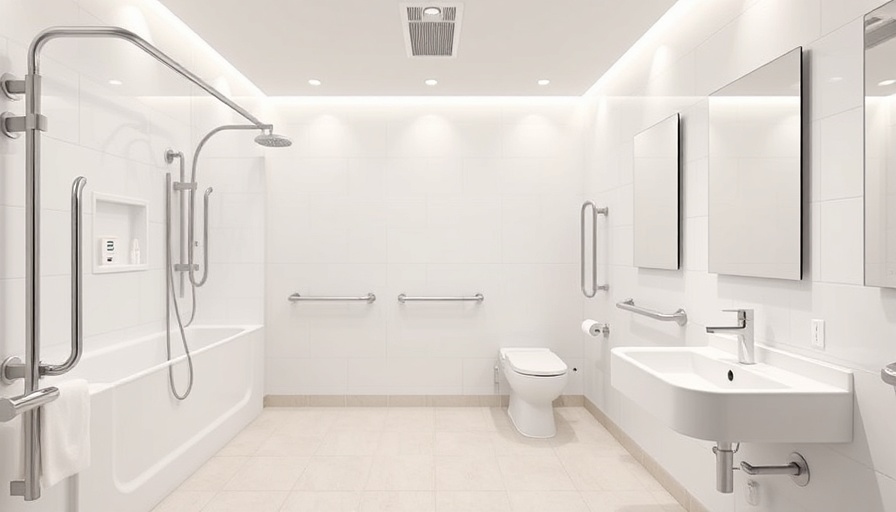
Why ADA Compliance is Crucial for Your Toms River Bathroom
Creating an ADA-compliant bathroom in Toms River is not merely about adhering to regulations; it’s about fostering inclusivity and ensuring comfort for all users, especially as we age or accommodate visitors with disabilities. These modifications enhance the usability of your home, providing safety and accessibility while potentially increasing its value. Let’s delve deeper into the essentials of crafting a bathroom that serves everyone effectively.
Key Elements of ADA Compliance You Should Know
The Americans with Disabilities Act (ADA) sets forth guidelines that dictate how to design accessible spaces, aiming to make facilities usable for individuals with various mobility challenges. Understanding these specifications is essential when planning your bathroom renovation.
For instance, door widths must reach at least 32 inches to permit wheelchair access, while sinks, toilets, and showers must be positioned strategically to ensure ease of use. Familiarizing yourself with these dimensions can help you avoid unnecessary complications and expenses down the line, ensuring your remodeling project stays on course.
Essential Features for an Accessible Bathroom
Incorporating specific ADA features into your bathroom does more than enhance compliance; it also elevates functionality and user comfort. Consider installing grab bars at critical locations such as next to the toilet and in the shower, ensuring they’re firmly anchored and between 33 and 36 inches high for efficient support.
Designing your floor space with a turning radius for wheelchair users—ideally a 60-inch diameter—is also pivotal. Opt for non-slip flooring to minimize fall risks, especially in areas prone to wetness.
Optimal Fixture Placement for Comfort and Safety
Your choice of fixtures plays a significant role in creating an accessible environment. Sinks should be mounted to allow adequate knee clearance—typically not exceeding a height of 34 inches—while toilets should feature a height of 17 to 19 inches from the floor. These modifications facilitate a more comfortable experience for users.
Bathroom Solutions that Promote Independence
Showering is an essential function of the bathroom; therefore, ensuring a seamless and safe bathing experience is invaluable. The ADA calls for roll-in showers to have a minimum dimension of 60 inches by 30 inches, with adequate slope for drainage. Installing a handheld showerhead on an adjustable bar is highly recommended, as this accommodates both seated and standing users.
When it comes to bathtubs, low-threshold models are preferable, significantly easing entry and exit for those with mobility impairments. Making these thoughtful choices enhances usability and keeps bath times safe and stress-free.
Making Your Renovation More Than Just Compliant
Beyond simple compliance, a well-designed, accessible bathroom offers emotional reassurance to its users. It creates a safe haven, allowing individuals to maintain their independence and dignity while performing daily tasks. By investing in ADA features, you are sending a clear message to loved ones and guests—everyone matters, and their comfort is a priority.
Finding the Right Professionals for Your Toms River Renovation
For effective implementation of these guidelines, partnering with competent bathroom remodel contractors in New Jersey is paramount. These professionals not only understand the nuances of ADA compliance but also specialize in creating stunning, functional spaces tailored to your needs. From DEO Kitchen & Bath in Hoboken to local experts like Bathroom Pros in Toms River, the right contractor can streamline your renovation process thanks to a wealth of experience in accessibility upgrades.
Lastly, consider projects like those detailed in Best of NJ to find tips and tricks straight from experts, ensuring your new bathroom is not only compliant but also beautifully inviting.
In Conclusion: Renovate with Confidence and Care
With an increased focus on inclusivity and accessibility, now is the time to ensure your Toms River bathroom renovation thoughtfully adheres to ADA compliance. By incorporating key design elements and enlisting qualified professionals to guide your decision-making, you can foster an environment that promotes safety and dignity for all users.
Take the first step towards your accessible bathroom today! Explore your options and start reimagining a space that welcomes everyone.
 Add Row
Add Row  Add
Add 




 Add Row
Add Row  Add
Add 

Write A Comment